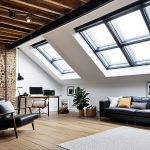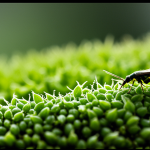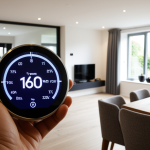Practical Solutions for Thriving Indoor Gardens in Low-Light UK Homes
Low-light conditions in UK homes often challenge indoor gardens, but understanding key factors can transform these spaces. When setting up indoor gardens, consider the natural light cycle and intensity. North-facing rooms or spaces blocked by buildings typically provide less light, requiring strategic plant choices and supplementary care.
For low-light living walls, selecting plants that naturally thrive with minimal sunlight is essential. Varieties like Spathiphyllum (peace lily), Pothos, and Philodendron adapt well to dim conditions, maintaining vibrant foliage without intense light. These plants reduce the impact of lighting limitations, allowing your indoor garden to flourish.
Also to discover : Revamp your uk loft: innovative cooling solutions on a budget
To overcome low-light challenges, incorporate reflective surfaces and adjustable LED grow lights to enhance light distribution. Position plants closer to windows or under skylights, if possible, and rotate them regularly to ensure balanced growth.
Plant care in these environments demands attentiveness to watering and humidity. Overwatering can harm plants in shaded areas, so frequency should be adjusted accordingly. Monitoring moisture levels and using a humidity tray can support plant health, ensuring your indoor garden remains lush even without abundant natural light in UK homes.
Also to read : Transforming your uk garden into a safe play oasis: top tips for overcoming uneven terrain challenges
Practical Solutions for Thriving Indoor Gardens in Low-Light UK Homes
Creating thriving indoor gardens in low-light UK homes requires a strategic approach tailored to lighting and space constraints. Start by assessing your home’s natural light patterns—understanding which areas receive indirect or minimal sunlight helps in planning your low-light living walls effectively. These walls need plants that can adapt to diffuse or filtered light without stress.
To overcome lighting limitations, supplement natural light with adjustable LED grow lights designed for indoor gardening. These lights can be timed to mimic daylength, enhancing photosynthesis in shaded interiors. Reflective surfaces near your garden, such as white walls or mirrors, can significantly increase light exposure by bouncing available light onto the foliage.
Choosing appropriate plants is crucial. Beyond popular options like Spathiphyllum and Pothos, consider shade-tolerant ferns or snake plants that maintain health in dim conditions. Incorporate a rotation schedule—moving plants periodically between brighter and darker spots—to maintain even growth and reduce leaf yellowing.
Plant care in such environments demands careful watering practices; overwatering is common when sunlight is limited. Monitor soil moisture closely and adapt humidity control using trays or humidifiers to keep the delicate balance essential for indoor gardens in UK homes with low light.
Practical Solutions for Thriving Indoor Gardens in Low-Light UK Homes
Creating successful indoor gardens in low-light UK homes requires a strategic approach to plant selection and environment optimization. Since natural light is limited, especially in north-facing rooms or densely built surroundings, choosing plants naturally suited to low-light conditions is critical. Varieties like Spathiphyllum, Pothos, and Philodendron excel because they efficiently photosynthesize under reduced light, ensuring vibrant growth without direct sun.
To counteract lighting limitations, use adjustable LED grow lights positioned to distribute light evenly across your low-light living walls, mimicking natural cycles. Reflective surfaces such as mirrors or light-colored walls amplify available light, enhancing photosynthesis. Placing plants closer to available light sources, such as windows or conservatory panels, also improves vitality.
In addition to light management, precise plant care is vital. Reduced sunlight slows soil evaporation, so tailor watering routines carefully to avoid overwatering, which can lead to root rot. Use moisture meters to monitor hydration levels accurately. Managing indoor humidity with trays of water or humidifiers supports healthy leaf development by reducing stress caused by dry air in heated UK homes.
By combining suitable plant care practices with adaptable light solutions, your indoor garden can thrive despite the challenges posed by low-light UK homes.
Practical Solutions for Thriving Indoor Gardens in Low-Light UK Homes
Creating flourishing indoor gardens in low-light UK homes demands a careful balance of plant choice, placement, and environment management. When natural light is scarce, low-light living walls must feature plants that thrive with indirect or minimal exposure. Species like Spathiphyllum, Pothos, and Philodendron are ideal, as they photosynthesize efficiently even in shaded conditions.
To overcome lighting limitations, supplement your garden with adjustable LED grow lights that simulate natural daylight cycles. This approach enhances photosynthesis and encourages robust growth. Placement near windows or reflective surfaces can amplify available light, further aiding plant vitality.
Effective plant care is crucial in such environments. Overwatering is a common pitfall in low-light settings, as soil retains moisture longer without direct sunlight. Tailor watering schedules by checking soil moisture regularly and using moisture meters if possible. Humidity control also supports healthier foliage; employing trays filled with water or humidifiers combats overly dry indoor air typical in UK homes during colder months.
By integrating strategic lighting solutions with attentive plant care, indoor gardens in low-light UK homes can achieve vibrant, sustainable growth despite challenging conditions.
Practical Solutions for Thriving Indoor Gardens in Low-Light UK Homes
Creating sustainable indoor gardens in low-light UK homes involves strategic choices beyond light enhancement. Begin with selecting plant varieties specifically suited for low-light living walls. Species like Calathea, Zamioculcas zamiifolia (ZZ plant), and Aspidistra complement the classic Spathiphyllum and Pothos, thriving in dimmer spaces by efficiently utilising limited light for photosynthesis.
Addressing lighting limitations requires more than grow lights. Position plants to benefit from indirect light angles, such as near east- or west-facing windows, where morning or afternoon light is available. Use reflective surfaces strategically to scatter light across the garden, maximizing plant exposure without artificial means.
For plant care, adjust watering to avoid waterlogging—soil drains slower in low light, increasing root rot risk. Employ well-draining substrates and consider aerating the soil periodically to promote root health. Nutrient delivery is equally crucial; low-light plants often need tailored fertilisers with balanced nitrogen to support foliage development without overstimulating growth.
Successful indoor gardens in UK homes balance thoughtful plant care with informed plant selection and environment adaptation. This holistic approach fosters vibrant low-light living walls that enhance interiors while respecting the challenges of natural light scarcity.
Practical Solutions for Thriving Indoor Gardens in Low-Light UK Homes
Low-light conditions in UK homes demand targeted plant care and smart design for indoor gardens to prosper. Selecting plants adapted to shaded environments ensures your low-light living walls remain vibrant without excessive resource input. Species like Calathea, Zamioculcas zamiifolia (ZZ plant), and Aspidistra complement classic choices such as Spathiphyllum and Pothos, flourishing under indirect or minimal light typical in many UK interiors.
Strategic placement is equally crucial. Positioning plants near east- or west-facing windows maximises limited sunlight exposure. Incorporating reflective surfaces like light-coloured walls or mirrors effectively scatters available light onto your indoor gardens. Adjustable LED grow lights should be used judiciously to supplement these natural gains, maintaining a balanced light regime necessary for healthy photosynthesis.
Proper watering schedules tailored to low-light conditions are essential; soil retains moisture longer without strong sunlight, increasing the risk of root rot. Use well-draining substrates to improve aeration, and monitor moisture levels regularly, employing tools like moisture meters when possible. Nutrient application must be calibrated to avoid overstimulation, favouring balanced fertilisers that support steady, sustainable growth in indoor gardens within UK homes faced with light scarcity.
Practical Solutions for Thriving Indoor Gardens in Low-Light UK Homes
Creating flourishing indoor gardens in low-light UK homes starts with understanding essential factors that influence plant health under limited light. The key is to select plant varieties inherently suited to dim conditions and adapt plant care routines accordingly.
For low-light living walls, species like Calathea, Zamioculcas zamiifolia (ZZ plant), and Aspidistra are excellent choices due to their ability to photosynthesise efficiently with minimal sunlight. Integrating these with classic options such as Spathiphyllum and Pothos provides structural diversity and resilience.
To overcome light scarcity, position plants strategically near indirect light sources — for instance, east- or west-facing windows where softer morning or afternoon sunlight penetrates. Reflective walls or surfaces can multiply available light, maximizing exposure without excessive energy use.
Effective plant care includes watering adjustments since shaded gardens retain moisture longer; overwatering risks root decay here. Using well-draining soil and moisture meters helps maintain optimal hydration. Additionally, aerating soil prevents compaction, supporting healthy root development in confined indoor spaces.
Balanced fertilisation tailored to low-light plants supports strong foliage without overwhelming energy needs. This holistic approach—careful plant selection, optimized placement, refined watering, and nourishment—enables vibrant, sustainable indoor gardens in challenging UK homes.






